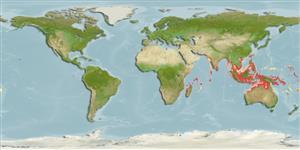Teleostei (teleosts) >
Pleuronectiformes (Flatfishes) >
Soleidae (Soles)
Etymology: Synaptura: Greek, syn, symphysis = grown together + Greek, aptein = to join + Greek, oura = tail (Ref. 45335).
Eponymy: Dr Philibert Commerson (1727–1773) was known as ‘doctor, botanist and naturalist of the King’. [...] (Ref. 128868), visit book page.
More on author: Lacepède.
Environment: milieu / climate zone / depth range / distribution range
Ecology
Marine; brackish; demersal; amphidromous (Ref. 51243). Tropical
Indo-West Pacific: Red Sea to the Persian Gulf, west coast of India and Sri Lanka; also off Mauritius and Seychelles. Also east coast of India to the Malay Archipelago.
Size / Weight / Age
Maturity: Lm ? range ? - ? cm
Max length : 36.0 cm TL male/unsexed; (Ref. 108711); common length : 30.0 cm TL male/unsexed; (Ref. 30573)
Inhabits mainly sand and mud bottoms in coastal waters. Feeds mainly on benthic invertebrates, especially small crustaceans. Marketed fresh, frozen, and dried-salted.
Life cycle and mating behavior
Maturity | Reproduction | Spawning | Eggs | Fecundity | Larvae
De Bruin, G.H.P., B.C. Russell and A. Bogusch, 1995. FAO species identification field guide for fishery purposes. The marine fishery resources of Sri Lanka. Rome, FAO. 400 p. (Ref. 11298)
IUCN Red List Status (Ref. 130435: Version 2024-1)
Threat to humans
Harmless
Human uses
Fisheries: commercial
Tools
Special reports
Download XML
Internet sources
Estimates based on models
Preferred temperature (Ref.
123201): 26.2 - 28.8, mean 28.1 °C (based on 322 cells).
Phylogenetic diversity index (Ref.
82804): PD
50 = 0.5156 [Uniqueness, from 0.5 = low to 2.0 = high].
Bayesian length-weight: a=0.00977 (0.00571 - 0.01672), b=3.06 (2.91 - 3.21), in cm total length, based on LWR estimates for this species & (Sub)family-body (Ref.
93245).
Trophic level (Ref.
69278): 3.5 ±0.44 se; based on food items.
Resilience (Ref.
120179): Medium, minimum population doubling time 1.4 - 4.4 years (Preliminary K or Fecundity.).
Fishing Vulnerability (Ref.
59153): Low to moderate vulnerability (26 of 100).
